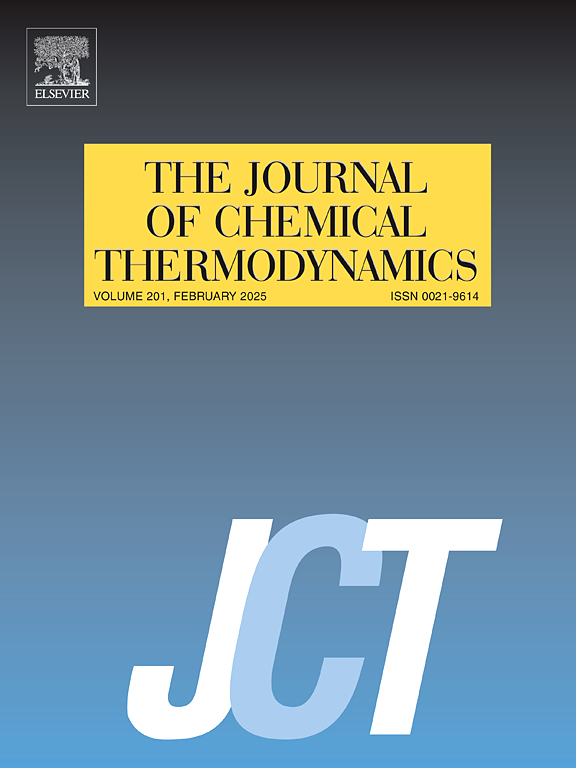Volumetric and viscometric study of caffeine in aqueous D-sorbitol solutions
IF 2.2
3区 工程技术
Q3 CHEMISTRY, PHYSICAL
引用次数: 0
Abstract
Densities and viscosities of caffeine in various aqueous molal solution [m = (0.005–0.020) mol kg−1] of D-sorbitol were measured at T = (298.15–318.15) K and ambient pressure P = 101 kPa. A number of volumetric, viscometric and thermodynamic properties like apparent molar volumes, standard partial molar volumes, apparent specific volumes, standard isobaric partial molar expansibilities and their temperature dependence, viscosity B-coefficients, solvation number, etc., have been determined from the measured data. Further, the standard volume of transfer and viscosity B-coefficient of transfer for caffeine from water to aqueous D-sorbitol solutions were derived in order to have insights into the variety of interactions in the ternary solutions. In terms of solute–solvent and solute–solute interactions, the effects of molality, solute structure, temperature and taste behavior were examined. These findings showed that caffeine acts as a structure maker and that the solute–solvent interactions dominate in the ternary solutions. UV–visible and 1H NMR spectroscopic studies were performed to substantiate these findings. Further, bond length changes due to interaction between D-sorbitol and caffeine, molecular electrostatic potential maps, Mülliken charge distribution, etc., were also studied theoretically and correlated to various interactions in the studied solutions.
咖啡因在 D-山梨醇水溶液中的体积和粘度研究
在T = (298.15-318.15) K和环境压力P = 101 kPa条件下,测定了d -山梨醇水溶液中咖啡因的密度和粘度[m = (0.005-0.020) mol∙kg - 1]。许多体积、粘度和热力学性质,如表观摩尔体积、标准偏摩尔体积、表观比容、标准等压偏摩尔膨胀率及其对温度的依赖、粘度b系数、溶剂化数等,已经从测量数据中确定。此外,导出了咖啡因从水到d -山梨醇水溶液的标准转移体积和粘度b -转移系数,以便深入了解三元溶液中的各种相互作用。在溶质-溶剂和溶质-溶质相互作用方面,考察了质量摩尔浓度、溶质结构、温度和口感行为的影响。这些发现表明,咖啡因作为一个结构制造者和溶质-溶剂相互作用在三元溶液中占主导地位。紫外可见和1H核磁共振光谱研究证实了这些发现。此外,还从理论上研究了d -山梨醇与咖啡因相互作用引起的键长变化、分子静电势图、m lliken电荷分布等,并将其与所研究溶液中的各种相互作用相关联。
本文章由计算机程序翻译,如有差异,请以英文原文为准。
求助全文
约1分钟内获得全文
求助全文
来源期刊

Journal of Chemical Thermodynamics
工程技术-热力学
CiteScore
5.60
自引率
15.40%
发文量
199
审稿时长
79 days
期刊介绍:
The Journal of Chemical Thermodynamics exists primarily for dissemination of significant new knowledge in experimental equilibrium thermodynamics and transport properties of chemical systems. The defining attributes of The Journal are the quality and relevance of the papers published.
The Journal publishes work relating to gases, liquids, solids, polymers, mixtures, solutions and interfaces. Studies on systems with variability, such as biological or bio-based materials, gas hydrates, among others, will also be considered provided these are well characterized and reproducible where possible. Experimental methods should be described in sufficient detail to allow critical assessment of the accuracy claimed.
Authors are encouraged to provide physical or chemical interpretations of the results. Articles can contain modelling sections providing representations of data or molecular insights into the properties or transformations studied. Theoretical papers on chemical thermodynamics using molecular theory or modelling are also considered.
The Journal welcomes review articles in the field of chemical thermodynamics but prospective authors should first consult one of the Editors concerning the suitability of the proposed review.
Contributions of a routine nature or reporting on uncharacterised materials are not accepted.
 求助内容:
求助内容: 应助结果提醒方式:
应助结果提醒方式:


